The Versatile Neck Knife You Can Carry Horizontal, Vertical, and Upside Down, but Won’t Like Using
The Gerber Ghostrike is a versatile fixed blade that’s made to be packed anywhere in any fashion your heart desires. It’s an odd little thing that doesn’t seem to be made for any one task specifically, but has a tough enough build to potentially be used on anything.
Gerber put a lot of effort into making it work for any kind of vertical, horizontal, and inverted carry (I only found out about it because I was looking for horizontal carry knives specifically). That focus on versatility ends up holding the Ghostrike back, but it has created a tool that’s fun to play with if nothing else.
Unfortunately, the Gerber Ghostrike has been discontinued. You may want to check out our Neck Knife Guide here to find an alternative.
Specifications
| Overall Length: | 6.75″ |
| Blade Length: | 3.12″ |
| Blade Steel: | 420HC |
| Blade Grind: | Flat |
| Blade Style: | Drop point |
| Blade Thickness: | 0.08″ |
| Handle Length: | 3.63″ |
| Handle Material: | Steel w/ rubber grip |
| Weight: | 3.61 oz |
| Sheath: | Modular GFN |
| Made in: | USA |
| Price Range; | $40 – 50 |
Pros
| Highly versatile sheath |
| Easy to deploy |
| Works great with a ferrot rod |
| Very tough design |
Cons
| Works for most things but doesn’t excel at much |
| Doesn’t come very sharp |
| General design makes it tricky to cut with |
It’s Ugly but Likable
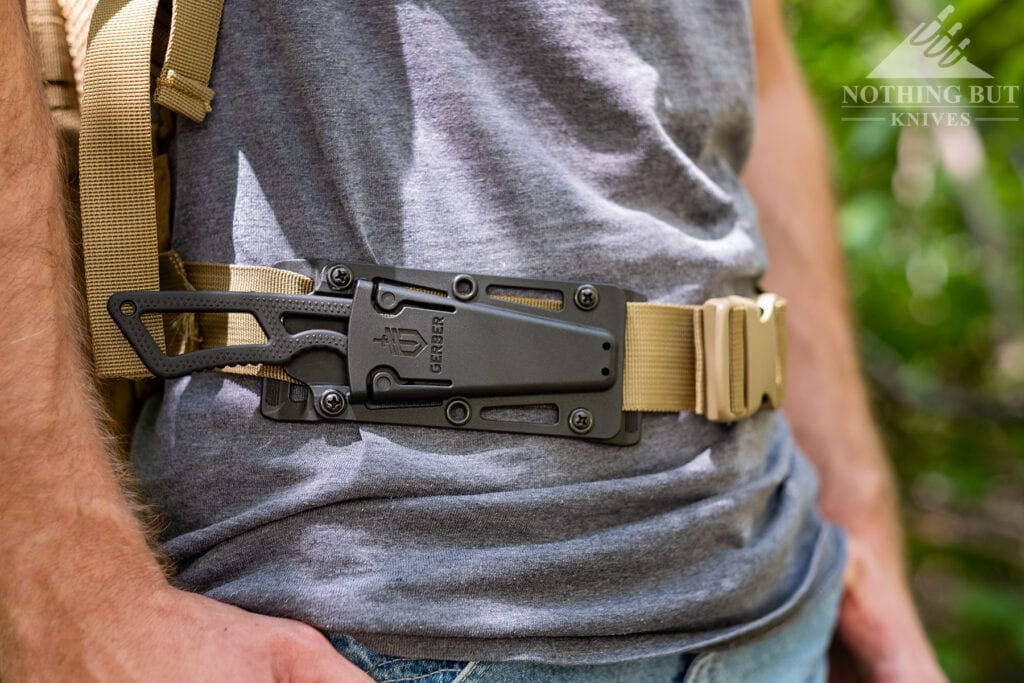
I had every intention of disliking this knife. Not just because it looks like someone smooshed a bug on a window, smeared it across, and outlined the gut streak to create the basis of the design, but because the name it dumb too. “Ghostrike” sounds like the user name of someone who developed an encyclopedic knowledge of assault rifles by improving their kill-to-death ratio in Call of Duty: Modern Warfare.
The thing just isn’t my style.
But people keep raving about the thing, and while I’ve just assumed they were the kind of people I don’t like, I decided it was time I took a second to stop judging them and try the knife out myself so I could disapprove of them with better accuracy.
So here I am, packing the Gerber Ghoststrike into the woods, pretending not to like it despite all its flaws.
Carrying and Deployment
The hook of this knife is that it can be carried in and on anything. The only limit to how you pack it on the trail or around town is limited only by your imagination.
It has a compact sheath made of tough composite with two strap loops that can be screwed into 6 different places on the sheath. Since the blade can go in the sheath facing either direction and the sheath retention is strong enough to hold the knife in upside down, it’s hard to find a spot the Ghostrike can’t work well in.
It’s not equally easy to pull it out in every direction, though. For example, it’s definitely more comfortable for me to carry this thing as a right-handed scout carry but it rides really close to my back, so if I want to pull it out in a traditional grip I really have to dig my fingers behind the handle. I found it was a lot quicker to just pull it out in an icepick grip, but there’s almost nothing I would do in an icepick grip with the Ghostrike, and the need to change my grip kind of negates the fast deployment feature of the knife.
Vertical vs. Horizontal Carry
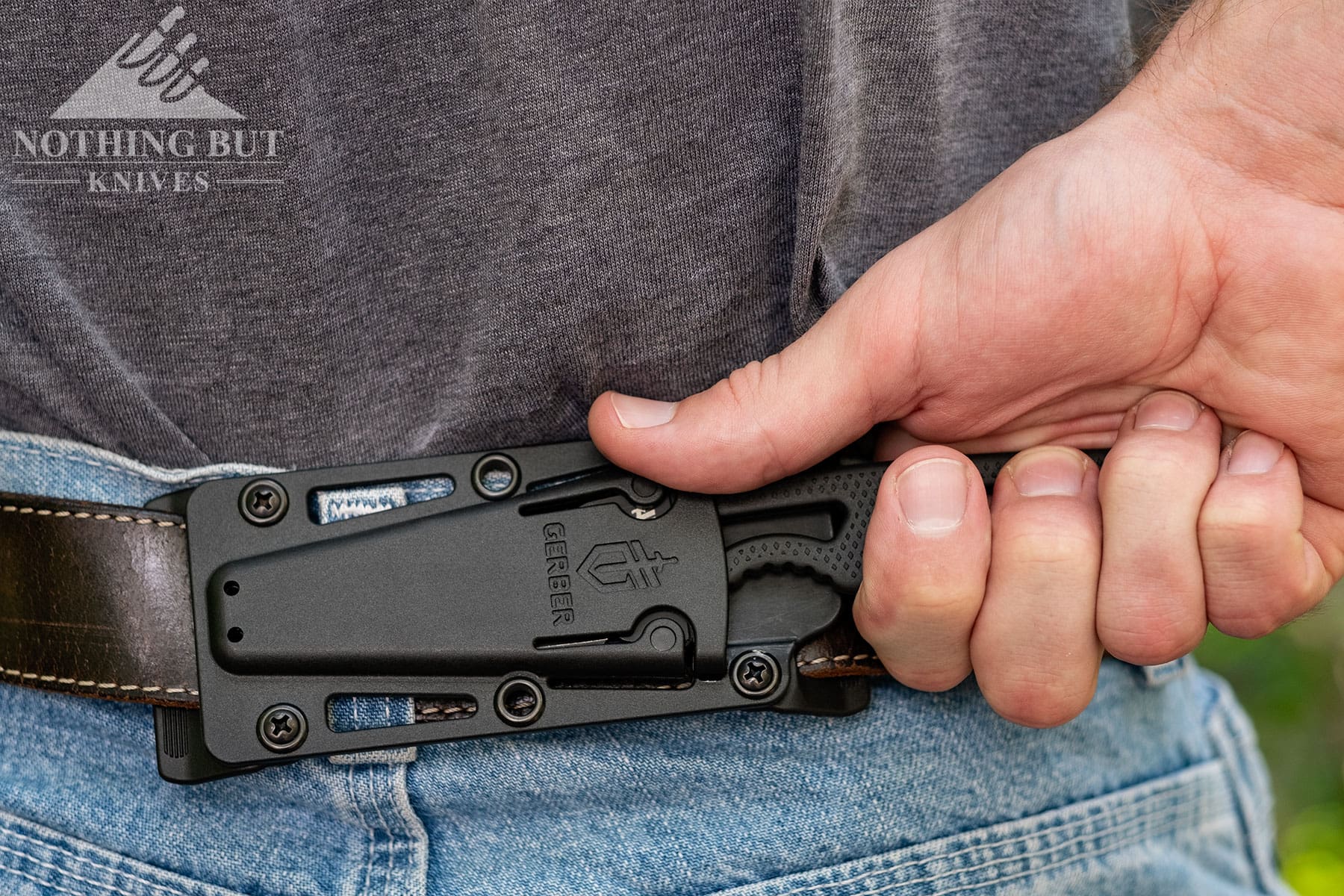
The general rule of thumb I’ve worked out from trying the Ghostrike in different places is to keep it either horizontal or upside down if you wear it on your upper body, and vertical upright if you’re wearing it below the waist.
On the belt, this is much easier to carry horizontally. Once you get the hang of getting your fingers around it, or pulling it backwards, there’s almost no situation you couldn’t get it out quickly so long as you have a free hand.
Vertical is a bit of a different story. The retention in the sheath is pretty tight, so you really have to yank it to get it out. Unless the knife is riding near your front, it’s an awkward motion to pull it up out of the sheath. Not that someone couldn’t do it quickly if they work on the motion (or are just stronger than me), but upright and vertical on the belt was the slowest and least comfortable of all the methods I tried.
If you want to get a little creative, it seems to work upside down pretty well. I wouldn’t want to hike through too much brush that way, but I was pulling it a little faster when I strapped it upside down to my back or sides. It makes the handle a lot easier to grab, and the motion of pulling it and bringing it around feels a lot more natural.
The Best Way is On the Leg
The Ghostrike gets described as a boot knife, but that’s not what I mean. Since my legs are the fattest part of my body I decided to strap it vertically around the upper part of my right leg and walk around with it that way. That was easily the fastest and surest place to pull the knife from. That way my hand is always resting near it, there’s no awkward motion in pulling it out, and I’m just more likely in general to remember that it’s there.
I wouldn’t walk around town like that, of course, but if I were backpacking or just going on a long hike, the leg is definitely where I’d keep the Ghostrike.
Converting the Sheath: Careful with the Screws
It’s easy enough to switch the strap loops on the sheath around but you have to be careful about losing or messing up the screws. The screws are thin and they can be a little janky. I’ve nearly cross threaded one of them a couple times so be wary of that. Sometimes you’ll also have to hold the bolt side down tight with your fingers or else the screw just spins the whole thing in place.
It can get a little frustrating if you’re in a hurry, but I managed to switch everything over with just a phillips screwdriver. If you’re in the field, you should be able to switch things around no problem if you’ve got a multitool.
The Blade and Lack of Sharpness
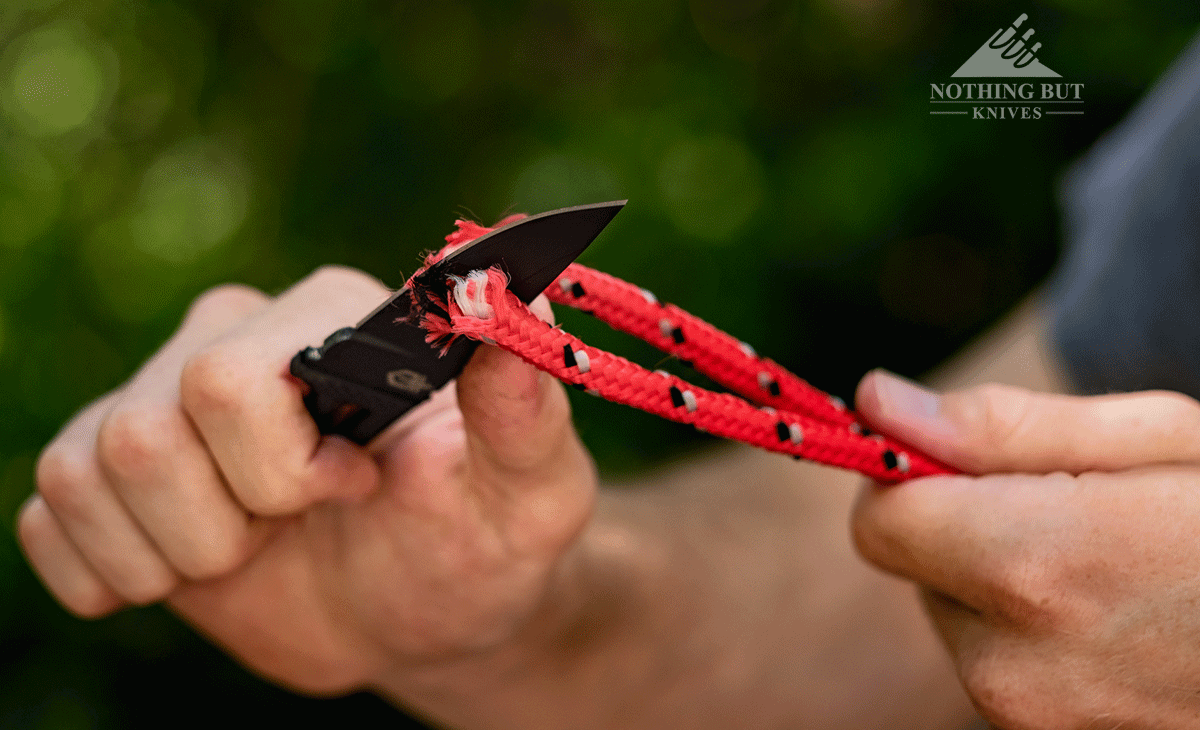
The factory edge on the Ghostrike is not going to shave any hairs off. It’s not exactly dull, but it feels like a well worn axe.
It did not do well at all on the paper test. In fact, it didn’t do anything on the paper test aside from crinkle the paper. Cardboard went a little better, but it took some doing before I got a cut started, and even then the size and shape of the knife just don’t make it a pleasant job.
It cut through our rope eventually, but I had to make maybe three or four cuts before it finally did any real damage. And these weren’t slashing or sawing cuts. These were repetitive push cuts, because frankly that’s the easiest way to cut anything with this knife.
You could get a sharper edge on it if you wanted to (and people have), but that won’t change the fact that the shape of the knife as a whole makes the process more difficult.
Good Steel, though
Everyone raves about Buck’s 420HC steel, and it’s probably still the best on the market, but Gerber isn’t too bad at the budget and mid range steels. It’s especially reliable in this shape since they’ve given the blade a short square-ish structure. I’ve hacked at a few branches with it and have yet to see signs of wear. I’m certainly not worried about chipping the edge. Actually, I’m not worried about damaging this knife at all. And not just because it’s ugly.
Gerber set out to make this a tough knife. They succeeded. Part of that is due to the actual shape of the knife, but a lot more is because of their steel. The down side is the Ghostrike takes more effort to sharpen, but once you get an edge, it should stay around for quite a while.
Design Intent and the Lack of Specialization
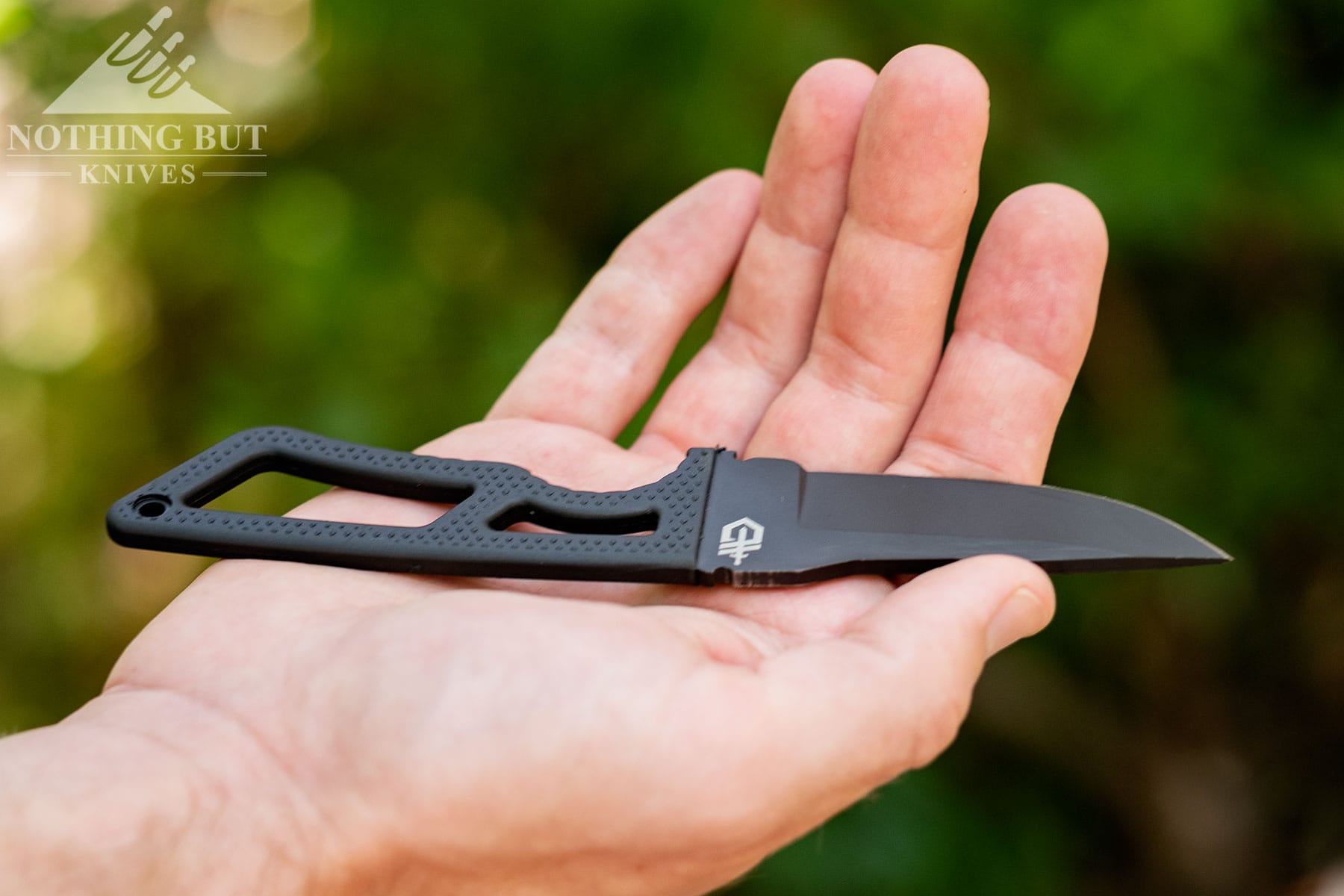
I’m not sure who designed this knife. The Gerber Ghostrike page isn’t dropping any hints, but they do say that “concealed carry lies at the heart of the design”. They have absolutely hit that part of it out of the park. You could find a way to conceal this knife with pretty much anything you’re wearing, and the rubber grip around the handle makes it really easy to grab onto, so quick deployment is usually easy too. That’s where the specialization ends though.
Sub Par for Bushcraft
If this knife were any bigger it would be slightly more useful as some kind of chopper, but it would lose some of its versatility. The Ghostrike is not a performance knife, and there’s nothing as far as I can tell that suggests it’s trying to be anything special. It’s the backup knife. It’s the thing to yank out when your other tools are either out of reach or failing you.
Aside from that, I really can’t picture any task I would want the Ghostrike for. At least, not as a first choice. It doesn’t feather particularly well. When I tried, my thumb kept rubbing against the wood because the blade is so small. Even if I got it sharpened up, it would still be a pain.
The handle is a little too thin to be comfortable, especially compared to anything made to be carried in the pocket or on the belt, and while it can get hammered through wood all day, it will take more effort to get anywhere with it than if you just used a hatchet or even a regular bushcraft knife.
Some Potential as a Survival Knife
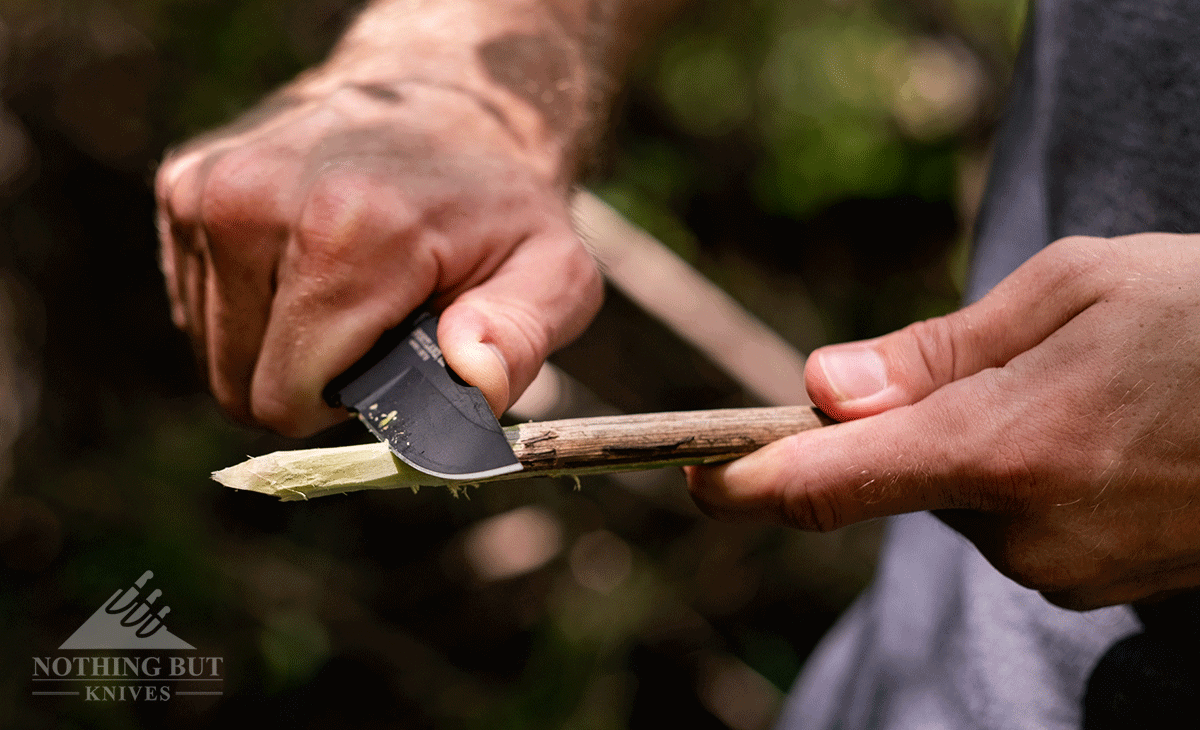
One thing this knife ended up doing very well was sparking with a ferrot rod. That’s where its size and shape start to shine. The spine has sharp edges, the ceramic coating makes a nice rough surface, and the thumb notch turns out to be a good catch for ferrot rods. You could throw sparks all day with this thing.
But while they’ve clearly carved out a notch in the spine for your thumb, and the whole thing really only works for push cuts, the shape of the blade had me rubbing my thumb against wood any time I tried to make a feather stick. In theory, the Ghostrike feels good, but in practice it’s kind of a nightmare.
Tricky as an Urban EDC or Tactical
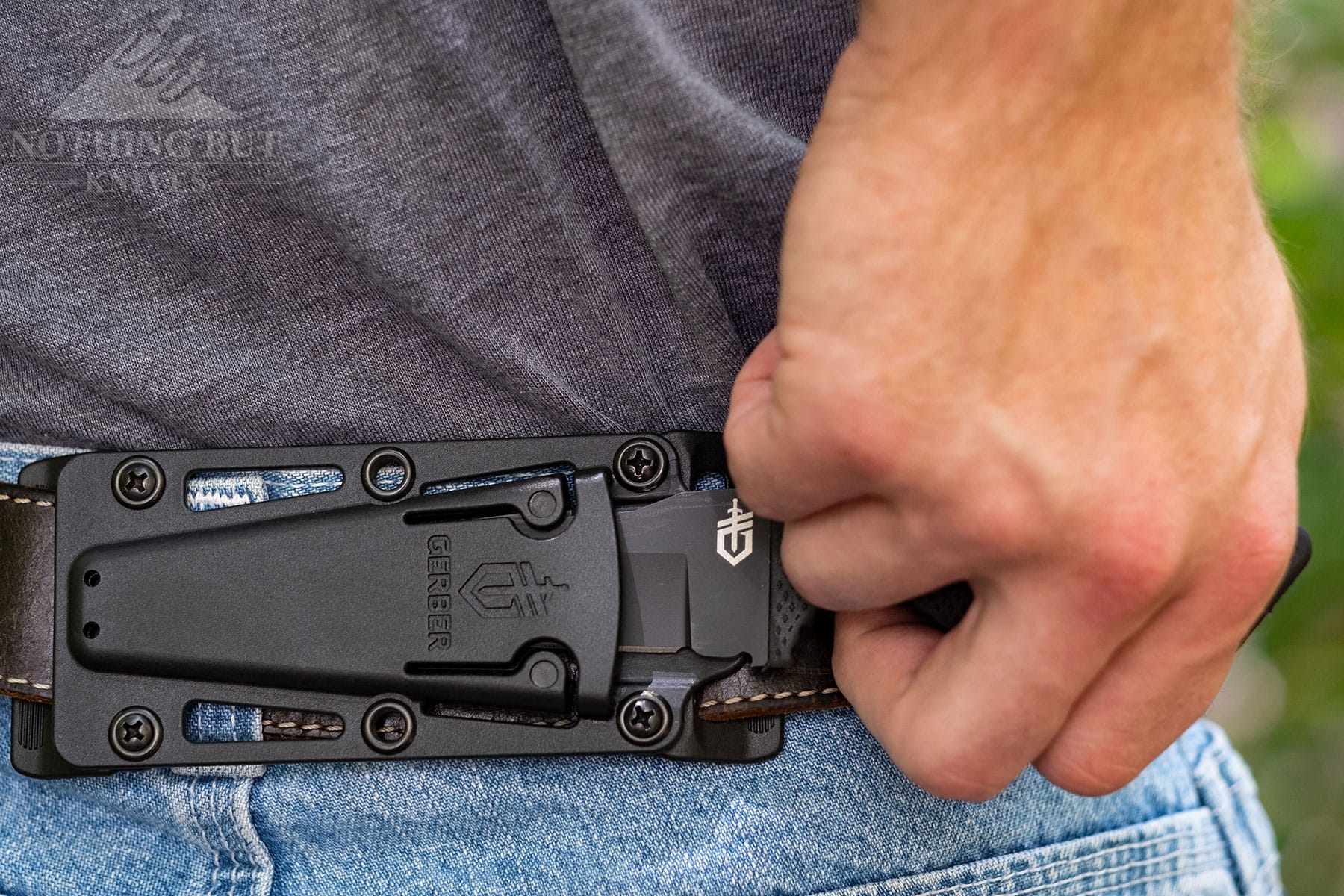
As far as urban carry goes, I don’t see it as a viable EDC for most areas. Since the strap loops are so thin it’s kind of a pain to get it situated on whatever you’re wearing. It’s fine once it’s on, but the process just doesn’t seem worth the trouble of doing it every day. The best way around that is probably to turn it into a neck knife, which should be easy enough to do if you just run a lanyard or chain through the holes in the sheath. But while it rides light and easy, it could also become a legal issue in some places as a concealed weapon with a blade over 3 inches.
It’s a viable tactical option, it’s just not the best one. If you practice drawing it enough you could get some really quick deployment with the Ghostrike. But again it’s not optimized for much beyond being drawn and carried easily. It’s a thick chunk of steel, but fighting with it or trying to break a window would be like trying to work with the head of a hammer: it’s probably better than using your bare hands, but it’s not going to feel good.
Knife Comparison
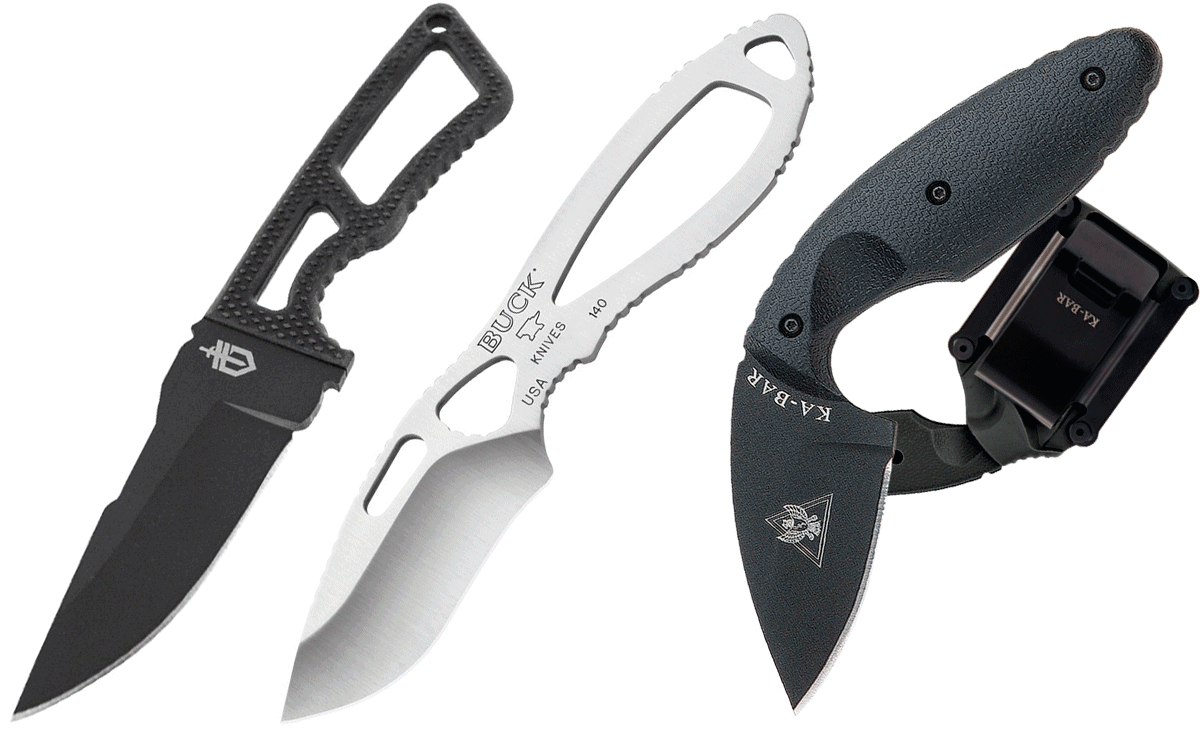
The sheath is the big stand out feature of the Ghostrike that puts it over other knives in the same size. Things get tricky once the blades are out, though. There are a few knives that come out looking better in both design and price.
The Other Urban Carry Knife
If you want to compare this to another concealable, tactically-minded knife, the Kabar TDI seems like a logical place to go. Even though the design is different, some of the intent is the same. It also usually runs around $15 – 20 cheaper. The blade is a little shorter, but the AUS- 8 steel is a slight upgrade in hardness, plus the plain spear point blade is more slicey than the bulky design of the Ghoststrike that I think works better for urban carry.
The Other Bushcraft and Hunting Knives
For more wilderness-oriented alternatives, there’s the Buck Packlite Skinner (runs around $20), which is a lot cheaper but has a much more specific design that won’t be as versatile as the Ghostrike, and the Esee Izula (runs around $50), which probably has a little more bushcraft usability, but isn’t built as well for concealed carry or the quickdraw.
The Other Neck Knife
If you’re just looking for a plain neck knife that can take some abuse, I’d also highly recommend looking into the Cold Steel Mini Tac, which has a similar skeletonized rubber grip and a small, tough blade build but is usually half the price (runs around $25 – 30). You can’t do as much with the sheath, but you can do a lot more with the knife itself.
Basically if you have a specific task in mind for your next knife like hunting or self defense, the Ghostrike probably isn’t your best option. Even as a backup knife, I’m hesitant to say it’s worth the price when the Mini Tac is out there. What you’re really paying for with the Ghostrike is the sheath.
Conclusion: A Good Backup Knife, but It Shouldn’t Be Your Only Knife
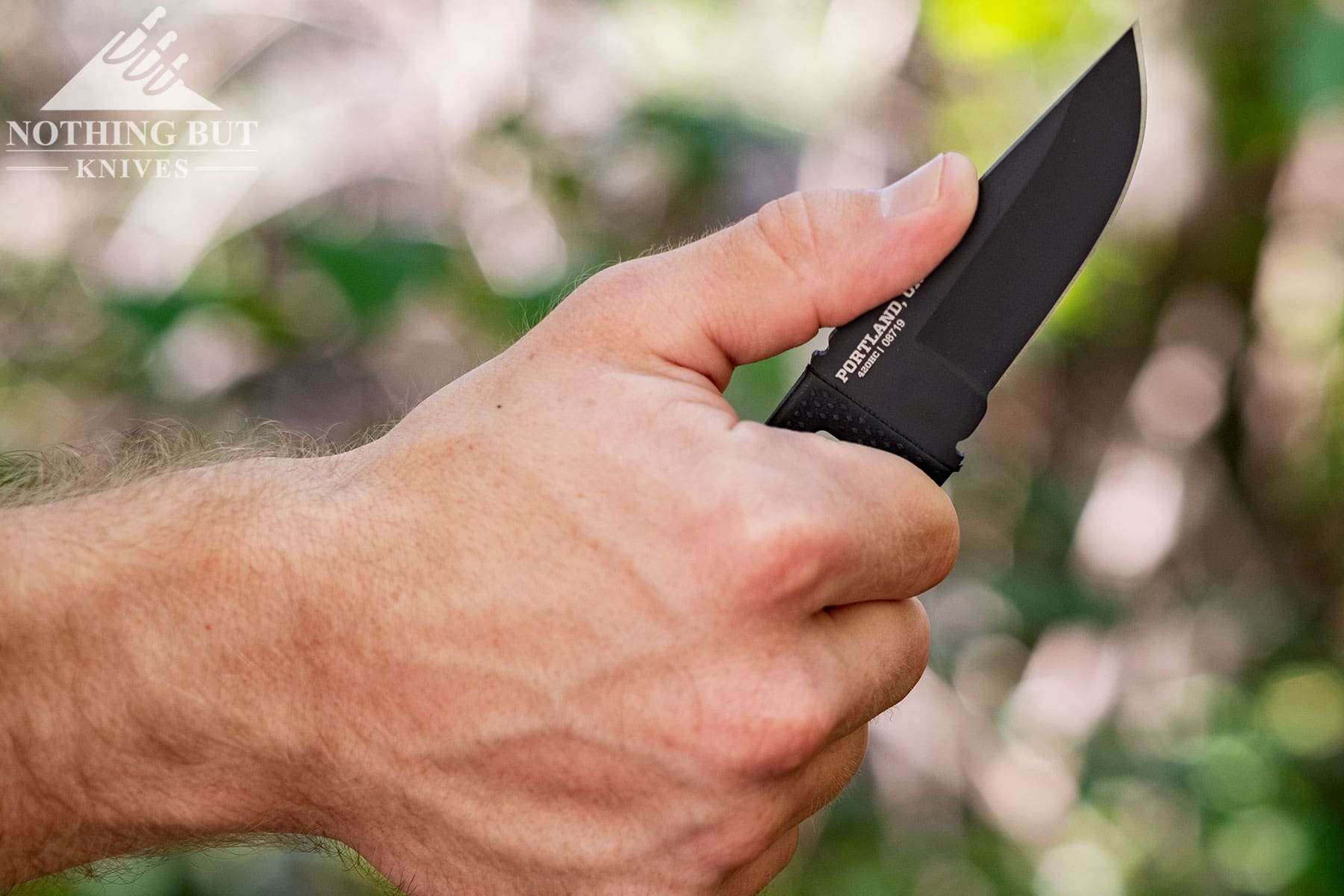
I’d recommend this knife mostly as something extra to take on a backpacking trip.
It’s a really small blade that isn’t all that sharp, and the style definitely isn’t optimized for skinning. This is not a hunting knife, and even though it’s easy to conceal and offers quick deployment, I’d be hard pressed to work out a tactical use for the thing.
What we have here is a tool that doesn’t necessarily specialize in anything but could potentially be used for everything. This makes it a rough bushcraft or survival knife, but an alright secondary knife. Check out our Survival knife Guide here or our Bushcraft Knife Guide here if you are looking for something bigger and more capable
Mostly the Ghostrike is fun to mess around with. There’s something to be said for the fact that I expected to hate this knife, then immediately changed my mind when I picked it up. I’m not going to carry it on a regular basis. It’s going to sit somewhere by my pointy camping gear pile, and I’ll only get it out to show it off to someone who fell into the trap of asking me any vaguely knife-related question.
It’s small and tough, it packs easy. It’s kind of cool in a scrappy way. And maybe it will save my life one day, but more likely it will just sit scout style somewhere on my pack for a few trips before I forget to bring it out entirely.

I do like the Gerber Ghoststrike. I’m left handed, so it was nice to have a knife I can carry without having to buy 5 other accessories to make it left handed. I carry it horizontal in the front, right by my buckle. I like how slime it is, people dont know I have it until I show them. It did take some practice to get the knife out & in the sheath, but I got it down pretty good. I will admit it’s not very sharp & when you get it sharp it doesn’t stay sharp for long. I use this knife a lot more at work, cutting wiring sheaths, boxes & zip ties!!!
It’s cool to hear about people still using this knife after all these years. Sounds like you found its ideal use case.